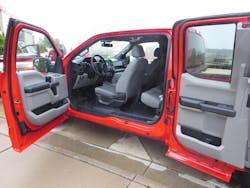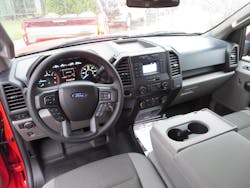Ford’s F-150 Diesel Is Quiet, Capable
Ford’s new F-150 Power Stroke diesel should now be at dealerships, and the oil-burner complements a rather extensive lineup of gasoline engines that helps make this pickup series the nation’s most popular vehicle of any kind. It also makes Ford competitive with the current Ram 1500 V-6 diesel and the upcoming DuraMax I-6 diesel for Chevrolet and GMC 1500 pickups. Meanwhile, with the recent runup in gasoline prices, Ford’s timing for the introduction of its new diesel seems spot on. Diesel fuel prices have gone up, too, but not near as much. Prices vary by region and locale, but in central Ohio, where I live, the two are within a dime or less of each other as I’m writing this, so the few thousand dollars extra for the diesel could be paid off rather soon. Or would it?
Buyers of the new 3-liter British-built V-6 diesel (right) should attain highway fuel economy of 30 mpg, along with 22 mpg city and 25 mpg combined, according to the EPA rating for a 2-wheel-drive version disseminated by Ford. With a light foot, highway economy could be a bit higher, representatives told truck writers during a ride-and-drive event earlier this year. That’s a few mpg better than a 3.5-liter EcoBoost gasoline V-6, which rates 18/25/21 mpg. The diesel’s economy advantage is 8.4 percent for the combined numbers, and it costs about $4,000 more. The payoff would depend on miles driven and how hard a truck works.
Actually, heavy loading should be the primary motivation for choosing the diesel-powered F-150 pickup over a gasoline engine, said Ford spokesman Mike Levine during the demo, held northwest of Denver using suburban streets and a mountain road. A diesel makes the most sense for people “who run fully loaded all the time, like landscapers, or someone who just wants a diesel,” he said. “And it will be an alternative for those who buy an F-250 just to get a diesel.” With its 1-ton payload and a tow rating of 11,000 pounds, an F-150 diesel will be nearly as capable. Ford expects only about 5 percent of buyers to choose the diesel, but because of the F-150’s high volume—896,764 last year—5 percent would still be a respectable proposition: 44,838, to be exact.
Although called a Power Stroke, the name and the material used in casting the block—compacted graphite iron—are the only things in common with the larger 6.7-liter V-8 diesel offered in heavier SuperDuty pickups. The new V-6 diesel “has its own architecture,” Levine said. It has conventional positioning for the intake and exhaust manifolds, inside the Vee and outside the two cylinder banks, respectively (the V-8s are the opposite). The new Power Stroke is a truck version of a diesel used in Range Rovers in Europe. It’s a Ford design built in a Ford plant in the United Kingdom.
The standard transmission is a new SelectShift 10-speed automatic, replacing the 6-speed automatic previously used. I used a thumb switch on column- and floor-mounted selectors to up- and downshift the tranny on a mountain road, Colorado 74, northwest of Denver. This helped control descents and eased the work of the service brakes. I downshifted all the way to 4th on a few of the steeper downgrades, then upshifted quickly. Gear numbers were displayed near the speedometer. It was fun and useful, and the tranny always changed ratios smoothly.
In the test runs, multiple ratios allowed the diesel to work in its most efficient speed, which when cruising was between 1,400 and 1,600 rpm, near its torque peak of 1,700, no matter the road speed. When pressed for more go-power, revs rose to 2,500 and 3,000, but with neither commotion nor smoke, either seen or smelled. Federal emissions regulations demand such good behavior, yet it’s still impressive.
The Power Stroke V-6 will be available in all F-150 trim levels except the top-of-the-line Limited, Levine said. The modest $4,000 upcharge over a 3.5-liter EcoBoost gasoline engine compares to about $9,000 for the 6.7 Power Stroke in a SuperDuty pickup. SuperDuties no longer have a larger cab, instead sharing the F-150’s aluminum structure. But it’s longer than before, so there’s little sacrifice in roominess. Of course, Ford offers three cab styles: 2-door Regular, the extended 4-door Super, and the longer 4-door SuperCrew. With one of the available upscale trims, the SuperCrew becomes a limousine with a truck bed instead of a trunk.
Most of the demo pickups had fancy trim levels, but the first one I grabbed was a basic XL SuperCab, loaded with a hefty stack of 2x4 boards said to weigh about 1,000 pounds, or half its listed payload capacity. The load made for a steady ride and the powertrain propelled us well. Designers didn’t skimp on sound-suppression, so the engine could be heard only faintly and there was little wind noise on a breezy day. While standing next to the truck as its engine idled, it would not be clear to a casual listener that a compression-ignition diesel was under the hood.
My third trip was in an F-150 with plusher Platinum trim, hitched to a boat trailer toting what looked like a heavy sport-fishing craft that weighed about 7,100 pounds. I ignored a suggested flat-road loop and took it on the same curvy mountain highway that solo F-150s used, where the trailer gave the diesel a slight workout and upset the truck’s ride. The trailer’s tongue had a crack-the-whip effect on the rear end; this caused bouncing that made its way into the cab and seats, resulting in moderate but annoying back slap. I think a pair of air-bag auxiliary springs over the rear leafs might smooth out the ride.
Still, if I towed a lot, I’d make pulling my trailer part of a test drive because an F-250 might be a better choice after all. But for most hauling and cruising chores, the new F-150 diesel is a smooth and capable machine that Ford fans will appreciate, whether they buy one or not.


